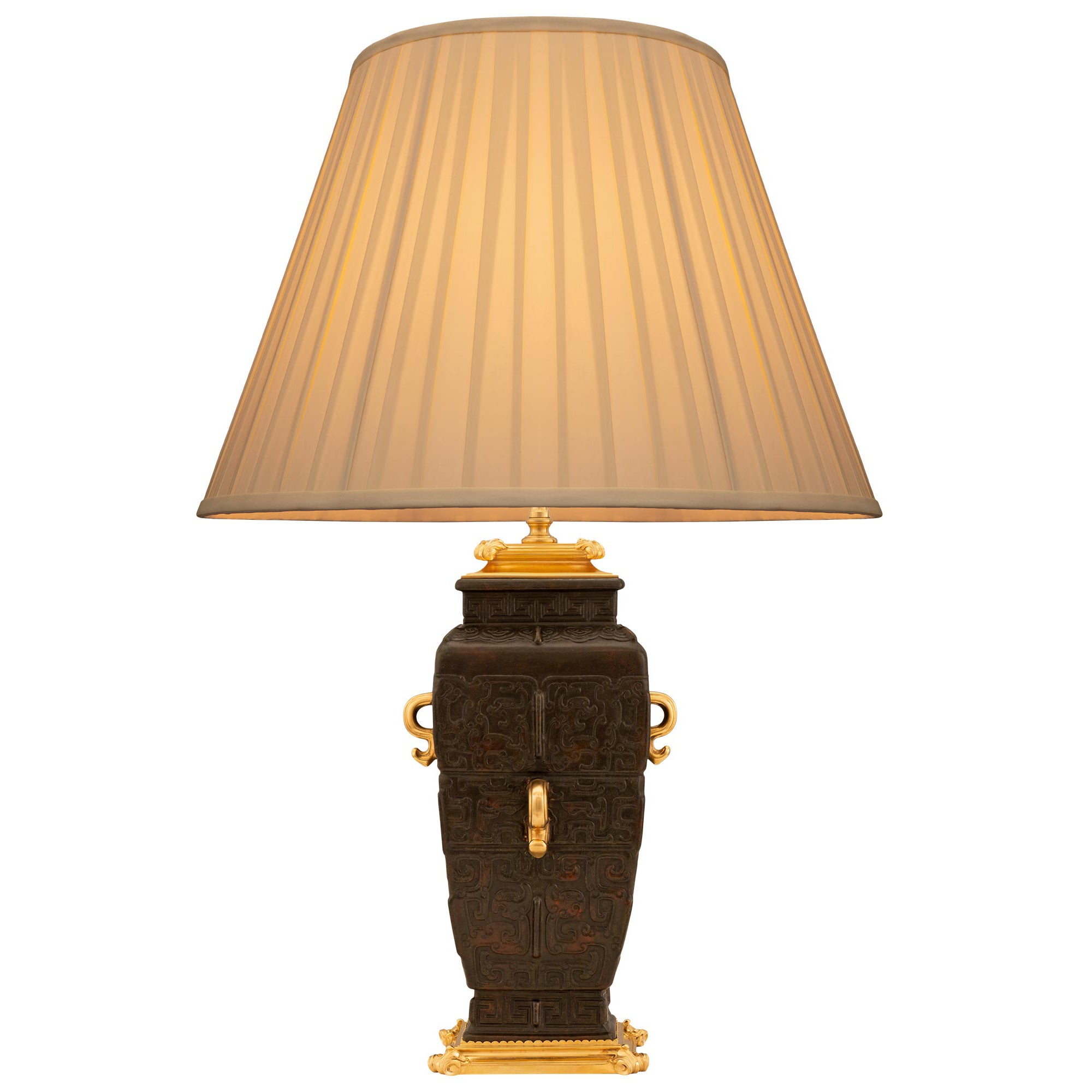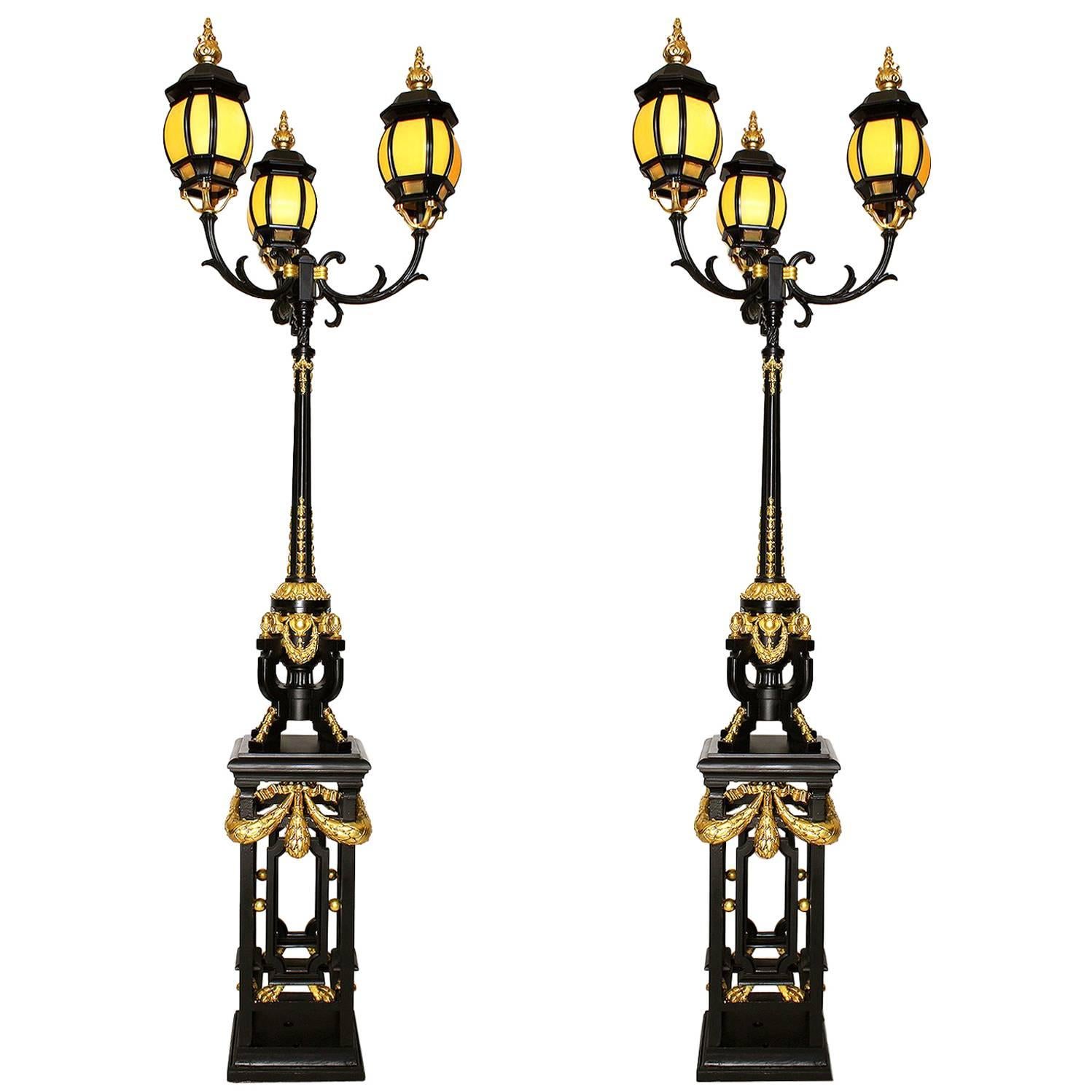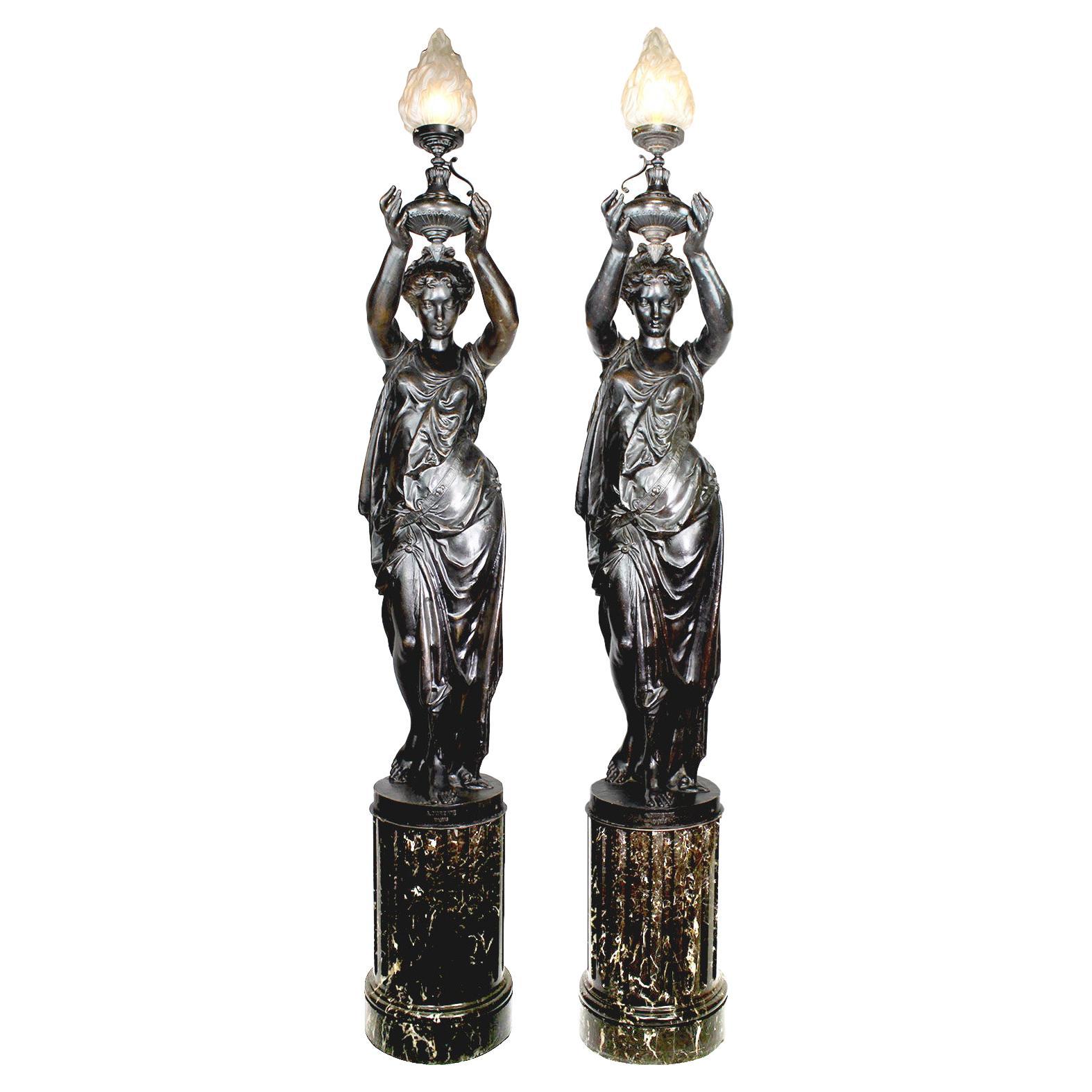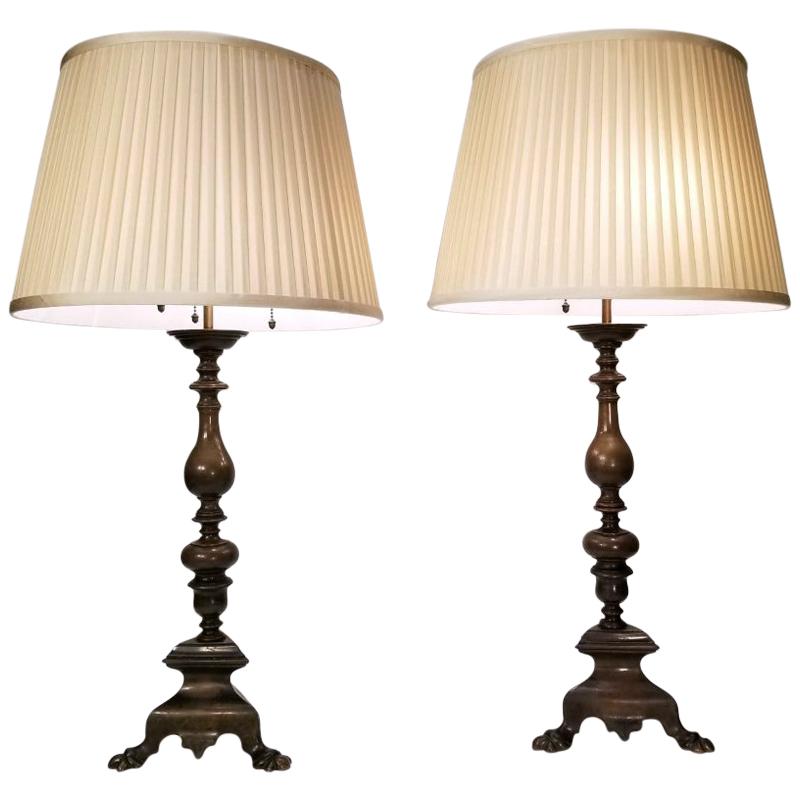Items Similar to Pompeiian Style 19th-20th Century Bronze Tripod Torchere, Attr. E.F. Caldwell
Want more images or videos?
Request additional images or videos from the seller
1 of 9
Pompeiian Style 19th-20th Century Bronze Tripod Torchere, Attr. E.F. Caldwell
About the Item
A Rare Tall Pompeiian Style 19th-20th century gilt patinated bronze tripod torchere Floor Lamp fitted with a molded glass shade. The tall fluted center column, topped with decorated ovoid white blown glass shade (later), the tripartite monopodium base with laurel-clasped and acanthus decorations and cabriolet lion-paws raised on tokens, attributed to E.F. Caldwell. Circa: 1890-1900.
Edward F. Caldwell & Co., of New York City, was one of the premier designers and manufacturers of electric light fixtures and decorative metalwork from the late 19th to the mid-20th centuries.
Measures: Height: 93 3/4 inches (238.2 cm)
Width: 19 inches (48.3 cm)
Depth: 19 inches (48.3 cm).
- Attributed to:Edward F. Caldwell & Co. (Metalworker)
- Dimensions:Height: 93.75 in (238.13 cm)Width: 19 in (48.26 cm)Depth: 19 in (48.26 cm)
- Power Source:Plug-in
- Voltage:110-150v
- Style:Empire Revival (In the Style Of)
- Materials and Techniques:
- Place of Origin:
- Period:1900-1909
- Date of Manufacture:circa 1880-1890
- Condition:Wear consistent with age and use. Minor fading. A truly beautiful floor lamp torchere, in the Empire revival flavor. The top white glass blown and decorated shade appears to be later. Please view all image.
- Seller Location:Los Angeles, CA
- Reference Number:
About the Seller
5.0
Vetted Seller
These experienced sellers undergo a comprehensive evaluation by our team of in-house experts.
Established in 1982
1stDibs seller since 2016
113 sales on 1stDibs
Typical response time: <1 hour
- ShippingRetrieving quote...Ships From: Los Angeles, CA
- Return PolicyThis item cannot be returned.
More From This SellerView All
- Fine French 19th-20th Century Louis XV Style Belle Epoque Gilt-Bronze TorchereLocated in Los Angeles, CAA fine and Large French 19th-20th century Louis XV Style Belle Époque gilt bronze four-light torchère with Laurel Wreaths with white opaline glass globes, raised on a two-tone circul...Category
Antique Early 1900s French Louis XV Floor Lamps
MaterialsMarble, Bronze
- Pair French 19th-20th Century Neoclassical Style Iron and Parcel-Gilt TorcheresLocated in Los Angeles, CAA Palatial Pair of French 19th/20th Century Neoclassical Revival Style Ebonized Cast-Iron and Parcel-Gilt Torcheres (torchières - Lamp Posts). The park-like torcheres surmounted with...Category
Antique Early 1900s French Neoclassical Revival Floor Lamps
MaterialsIron, Zinc
- Pair of French 19th-20th Century Neoclassical Style Cast Iron Figural TorchèresLocated in Los Angeles, CAA very fine pair of French 19th-20th century neoclassical style patinated cast iron figural torchères by A. Durenne, Paris, each representing a figure of a standing young maiden, her arms raised forward while holding a a flaming urn gas light (Now electrified) with a frosted glass flame, each raised on a veined grey marble column stand, both cast-signed 'A. Durenne, Paris'. Antoine Durenne was an internationally renowned French art founder. He attended École Nationale Supérieure des Beaux-Arts in 1842. Durenne purchased a small foundry in Sommevoire, near the Val d'Osne, Haute-Marne, France and established The Durenne firm, circa Paris, 1900. Cast-iron had been in production during the 18th century but its inferior status to the more fashionable and delicate wrought iron had generally confined its use to architectural work. By the early 19th century, however, rapid developments of the Industrial Revolution combined with the simultaneous burgeoning of a new middle class provided the impetus for a dramatic Expansion in its application and in a short space of time a proliferation of iron foundries across Europe and America thrived on the production of everything from inkstands to railway stations. The use of cast-iron for garden ornament became particularly widespread at this time, as the possibilities for its mass-production at a fraction of the cost of bronze made it the material of choice for outdoor statuary...Category
Antique Early 1900s French Neoclassical Revival Figurative Sculptures
MaterialsMarble, Iron
- Pair of 19th-20th Century Florentine Cut-Glass Fruit Girandole Table LampsLocated in Los Angeles, CAA pair of Italian 19th-20th century Florentine cut-clear and color glass four-lights girandoles table lamps. The scrolled bronze frame with four scrolled candle-arms, surmounted with...Category
Antique Early 1900s Italian Rococo Revival Table Lamps
MaterialsBronze
- Pair of French Belle Époque 19th-20th Century Gilt Bronze and Alabaster TorchereLocated in Los Angeles, CAA palatial pair of French Belle Époque 19th-20th century gilt bronze and alabaster tall torchières. The slender center column raised on a circular intri...Category
Antique Early 1900s French Belle Époque Floor Lamps
MaterialsAlabaster, Bronze
- Pair 19th Century Japanese Imari Porcelain & Gilt-Bronze Torchere CandelabraBy Imari PorcelainLocated in Los Angeles, CAA fine Pair of 19th century Japanese Imari Porcelain and French Gilt-Bronze Mounted Thirteen-Light Celadon Torchere Candelabra. The bottle-shaped Japonisme vases with a Royal red background, decorated with parcel-gilt and black soaring eagles in the hunt within a forestall scene. Each Vase fitted and surmounted with a French 19th century Louis XV Style 13-Light scrolled candelabrum and all raised on a circular pierced gilt-bronze plinth. circa: 1880. Imari Porcelain (????) is the name for Japanese porcelain wares made in the town of Arita, in the former Hizen Province, northwestern Kyushu. They were exported to Europe extensively from the port of Imari, Saga, between the second half of the 17th century and the first half of the 18th century. The Japanese as well as Europeans called them Imari. In Japanese, these porcelains are also known as Arita-yaki (???). Imari or Arita porcelain has been continously produced up through the present day. Characteristics Though there are many types of Imari, Westerners' conception of Imari in the popular sense is associated only with a type of Imari produced and exported in large quantity in mid-17th century. This type is called Kinrande. Kinrande Imari is colored porcelain with cobalt blue underglaze and red and gold overglaze. The color combination was not seen in China at that time. Traditional Ming dynasty color porcelain used dominantly red and green, probably due to scarcity of gold in China, whereas gold was abundant in Japan in those days. The subject matter of Imari is diverse, ranging from foliage and flowers to people, scenery and abstractions. Some Imari design structures such as kraak style were adopted from China, but most designs were uniquely Japanese owing to the rich Japanese tradition of paintings and costume design. The porcelain has a gritty texture on the bases, where it is not covered by glaze. There is also blue and white Imari. Kakiemon style Imari is another type of Imari, but it tends to be categorized separately in Europe. History "Imari" was simply the trans-shipment port for Arita wares. It was the kilns at Arita which formed the heart of the Japanese porcelain industry. Arita's kilns were set up in the 17th century, when kaolin was discovered in 1616 by the immigrant Korean potter, Yi Sam-pyeong (1579–1655). (He may also be known by the name, "Kanage Sambei".) Yi Sam-Pyeong, along with his extended family of 180 persons, left Korea on the offer of a privileged position in Japan. This decision was made after the occurrence of certain Japanese invasions of Korea. After Yi Sam-Pyeong's discovery, his kilns began to produce revised Korean-style blue and white porcelains, known as "Shoki-Imari". In the mid-17th century there were also a lot of Chinese refugees in Northern Kyushu due to the turmoil on Chinese continent, and it is said one of them brought coloring technique to Arita. Thus Shoki-Imari developed into Ko-KutaniImari. Ko-Kutani was produced around 1650 for both export and domestic market. Blue and white porcelain continued to be produced and they are called Ai-Kutani. Ko-Kutani Imari for the export market usually adopted Chinese design structure such as kraak style, whereas Ai-Kutani for the domestic market were highly unique in design and are accordingly valued very much among collectors. Ko-Kutani style evolved into Kakiemon style Imari, which was produced for about 50 years around 1700. Imari achieved its technical and aesthetic peak in Kakiemon style, and it dominated European market. Blue and white Kakiemon is called Ai-Kakiemon. Kakiemon style transformed into Kinrande in the 18th century. Kinrande used blue underglaze and red and gold overglaze, and later some other colors. Imari began to be exported to Europe because the Chinese kilns at Ching-te-Chen were damaged in the political chaos and the new Qing dynasty government stopped trade in 1656–1684. Exports to Europe were made through the Dutch East India Company, but the designation "Imari Porcelain" in Europe connotes Arita wares of mostly Kinrande Imari. Export of Imari to Europe stopped in mid-18th century when China began export to Europe again, since Imari was not able to compete against China due to high labor cost. By that time, however, both Imari and Kakiemon style were already so popular among Europeans, Chinese export porcelain copied both Imari and Kakiemon style, which is called Chinese Imari. At the same time, European kilns, such as Meisen also tried to copy Imari and Kakiemon. Export of Imari surged again in late 19th century (Meiji era) when Japonism flourished in Europe. Thus in western world today, two kinds of Imari can...Category
Antique 19th Century Japanese Japonisme Floor Lamps
MaterialsOrmolu, Bronze
You May Also Like
- American 19th Century Patinated Bronze and Ormolu Lamp by E.F. Caldwell & Co.By Edward F. Caldwell & Co.Located in West Palm Beach, FLA remarkable and very unique American 19th century patinated bronze and ormolu lamp by E.F. Caldwell & Co. The lamp is raised by an elegant square ormolu base with a fine wrap around...Category
Antique 19th Century American Table Lamps
MaterialsBronze, Ormolu
- Neo-Classical Style Patinated Bronze Lamp, E.F. Caldwell, Early 20th CenturyLocated in New York, NYInscribed E.F. Caldwell & co. Inc New York.Category
Early 20th Century American Table Lamps
MaterialsBronze
- Pair of Early 20th Century Baroque Style Caldwell Table LampsBy Edward F. Caldwell & Co.Located in Charleston, SCThese elegant pair of Caldwell lamps are in the Baroque style and bear a Tripod base with Baluster stem that is finished in a beautiful hand rubbed Bronze finish. These lamps come with the original three light cluster and acorn pull...Category
Early 20th Century Baroque Revival Table Lamps
MaterialsBronze
- Caldwell Style Bronze Tripod Pompeii Floor Lamp, circa 1900By Edward F. Caldwell & Co.Located in Kensington, MDRare tripod floor lamp in the Pompeiian style attributed to the Caldwell & Company foundry. Patinated bronze verdigris finish. Electrified with two sockets.Category
Antique Early 1900s American Classical Roman Floor Lamps
MaterialsBronze
- Georgian Style Giltwood Marble, Bronze & Crystal Torcheres by E F Caldwell, PairBy Edward F. Caldwell & Co.Located in Pittsburgh, PAThese amazing gilt bronze girandole form candelabra feature Robert Adam style decoration, including swag, rams heads, and acanthus leaves. They retain the original marble and carved giltwood stands...Category
Early 20th Century American Adam Style Floor Lamps
MaterialsBronze
- Silvered Bronze Lamp Attributed to E.F. CaldwellBy Edward F. Caldwell & Co.Located in Kilmarnock, VAStunning silver plated bronze lamp attributed to E.F. Caldwell, circa 1910.Category
Vintage 1910s American Table Lamps
MaterialsBronze, Silver Plate
Recently Viewed
View AllMore Ways To Browse
F Lighting
F Edward
Antique Bronze Lighting Fixtures
Antique Lighting Co
Antique Office Furniture Manufacturers
Antique Lighting New York
Antique Style Lighting Fixtures
Gilt Tripod
Antique Lamps New York
Edward F Caldwell
Edward F Caldwell Co
1900 Light Fixtures
Tripod Glass Top
Antique Lamp Co
Tripod Floor Light
Antique Lamp Fixtures
Torcheres Floor
Antique Tripod Lamp





